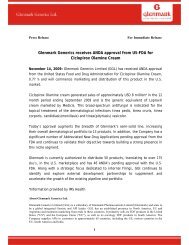Glenmark
Glenmark
Glenmark
You also want an ePaper? Increase the reach of your titles
YUMPU automatically turns print PDFs into web optimized ePapers that Google loves.
to the United States, a market noted for its litigious nature and high awards of damages. While we have a<br />
global product liability insurance policy for products sold by us, if any product liability claim not covered<br />
by insurance or exceeding the policy limits were sustained against us, it could adversely affect our business<br />
and financial condition. A deterioration in our quality controls could also result in product liability claims<br />
against us. The risk of product liability suits is also likely to increase as we develop our own new patented<br />
products in addition to making generic versions of drugs that have been in the market for some time.<br />
If we cannot respond adequately to the increased competition we expect to face in the future in India<br />
and abroad, we will lose market share and our profits will decline.<br />
The Indian Pharmaceutical industry is highly fragmented. Our products face intense competition from<br />
products developed, or under development, by other companies in India and abroad, including major<br />
pharmaceutical companies. We believe some of our competitors have broader product ranges, stronger<br />
sales and R&D teams and better segment positioning than us which enable them to compete more<br />
effectively. Many of our competitors have greater financial resources and marketing capabilities than we<br />
do. Some of our competitors, especially multinational pharmaceutical companies, have greater experience<br />
in clinical testing and human clinical trials of pharmaceutical products and in obtaining international<br />
regulatory approvals. Furthermore, following India’s adoption of the new patent regime in 2005, more<br />
multinational corporations have increased their focus on India and more multinational corporations may<br />
enter the Indian markets. If they do, we may not be able to compete with them effectively. We may also<br />
fail to introduce key products in the market at the relevant time or at a competitive price. Our competitors<br />
may succeed in developing technologies and products that are more effective, more popular or cheaper than<br />
any we may develop or licence. Our Indian competitors, particularly, in the recent past have resorted to<br />
extensive price-based competition. Should this continue, this could render our technologies and products<br />
obsolete or uncompetitive, limit our ability to introduce new products, and could adversely affect our<br />
business and financial results. In addition, APIs are commodity products and their prices can fluctuate<br />
sharply over short periods of time due to changes in demand, the price of raw materials and manufacturing<br />
efficiencies. Price competition among suppliers both in India and abroad is intense, with increasing<br />
competition from pharmaceutical companies in China and elsewhere that often price their products at lower<br />
rates than us. We compete with some of our API customers in the formulations business, which could affect<br />
such customers’ willingness to purchase our products. Increased competition could have a material adverse<br />
effect on our financial condition and results of operations.<br />
Our high leverage and security created in favour of lenders may impair our ability to obtain future<br />
financing.<br />
As at March 31, 2009 we had Rs. 20,943.46 million of total debt on a consolidated basis. As at March 31,<br />
2009, our debt to equity ratio was 1.31:1. After giving effect to the use of proceeds for this offering (on the<br />
basis of the assumptions described in the “As adjusted” column in the table shown under “Capitalization”,<br />
and in “Use of Proceeds”), our as adjusted debt to equity ratio would have been [•] as at March 31, 2009.<br />
See also “Capitalization”. In the event that actual net proceeds from the Issue utilized for the repayment of<br />
existing indebtedness are lesser than anticipated, our debt profile may not be reduced to the extent<br />
anticipated. Our relatively high debt to equity ratio is principally due to investments we made in several<br />
strategic projects, the majority of which were funded by borrowings. Our high leverage may continue to<br />
constrain our ability to raise incremental financing or the cost at which we could raise such financing.<br />
In addition, we have granted security in favour of our lenders over, among others, some of our immovable<br />
and movable property and our fixed and current assets pursuant to our loan and security agreements. If we<br />
are unable to fulfill our payment obligations under the loan agreements, our property and assets could be<br />
forfeited or transferred. These security arrangements also restrict our ability to grant security over our<br />
property and assets. The existing security in favor of our lenders over all or substantially all of our<br />
immovable and movable property and our fixed and current assets may furthermore substantially affect our<br />
ability to raise additional money and grant additional security.<br />
5



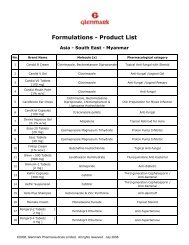


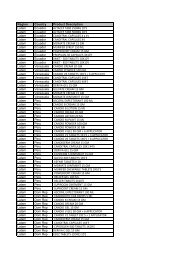
![Formulations [India] â Product List - Glenmark](https://img.yumpu.com/46601329/1/190x245/formulations-india-a-product-list-glenmark.jpg?quality=85)
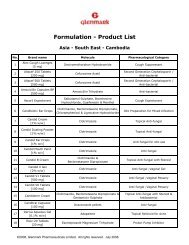
![Formulation [India] â Product List - Glenmark](https://img.yumpu.com/44013338/1/190x245/formulation-india-a-product-list-glenmark.jpg?quality=85)


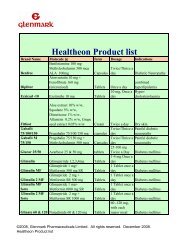
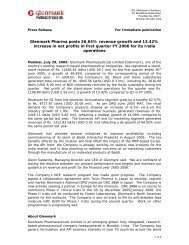
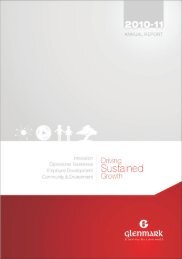
![Formulations [India] â Product List - Glenmark](https://img.yumpu.com/35994839/1/190x245/formulations-india-a-product-list-glenmark.jpg?quality=85)
